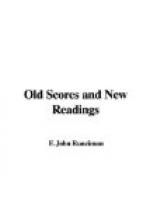force when need was, holding the sounds to the end
instead of letting them slink away ashamed in the accepted
Italian style. And not only were these things
in themselves delightful—they also served
to make the drama doubly powerful, and the tender parts
of the music doubly tender, to show how splendid in
many respects was Wagner’s art in the “Lohengrin”
days, and to prove that Maurel’s way of doing
the part of Telramund some years ago was, as Maurel’s
way of doing things generally are, perfectly right.
Maurel, it will be remembered, stuck a red feather
in his cap; and the eternally wise critics agreed
in thinking this absolutely wrong. They told him
the feather was out of place—it made him
appear ridiculous, and so on. Maurel retorted
that he was playing the part of a fierce barbarian
chief who would not look, he thought, like a gilded
butterfly, and that his notion was to look as ferocious
as he could. Now the odd thing is, that though
Maurel was right, we critics were in a sense right
also. As the music used to be played, a Telramund
one degree nearer to a man than the average Italian
baritone seemed ludicrously out of place; and when,
in addition, the Lohengrin was a would-be lady-killer
without an inch of fight in him, Henry the Fowler a
pathetic heavy father, and Elsa a sentimental milliner,
there was something farcical about Maurel’s
red feather and generally militant aspect. What
we critics had not the brains to see was that the playing
of the music was wrong, and that Maurel was only wrong
in trying to play his part in the right manner when
Lohengrin, Elsa, King, and conductor were all against
him in their determination to do their parts wrong.
Mr. Bispham follows in Maurel’s footsteps, as
he frequently does, in a modified costume, but when
for the first time the orchestra played right he would
not have seemed ridiculous had he stuck Maurel’s
red feather into his helmet. The whole scene became
a different thing: we were thrown at once into
the atmosphere of an armed camp full of turbulent
thieves and bandits itching for fighting, and wildly
excited with rumours of conflicts near at hand.
Amidst all this excitement, and amidst all the unruly
fighters, Telramund, strongest, fiercest, most unruly
of them all, has to open the drama; and to command
our respect, to make us feel that it is he who is
making the drama move, that it is because all the barbarians
are afraid of him that the drama begins to move at
all, he cannot possibly look too ferocious and hot-blooded,
too strong of limb and tempestuous of temper.
The proof that this (Seidl’s) reading of the
opera was the right one, was that, in the first place,
the drama immediately interested you instead of keeping
you waiting for the entry of Elsa; and, in the second
place, that the noisy, energetic playing of the opening
scene threw the music of Elsa and Lohengrin into wonderfully
beautiful relief—a relief which in the old
way of doing the opera was very much wanting.
To play “Lohengrin” in the old way is to




